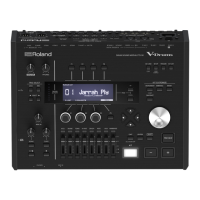20
Customizing a Kit
Choosing a Pad to Edit
Choosing by hitting a pad
To edit the settings for a pad, strike that pad to select it.
To select the rim of a pad, strike the rim.
Choosing with the SELECT [
K
] [
J
] buttons
You can also use the SELECT [
K
] [
J
] buttons to
select the pad (trigger input number) to edit.
When using a pad that provides rim support, the
[RIM] button lets you choose whether to make
settings for the head or for the rim. When using a
pad that provides three-way trigger support, this
button switches between head, rim, and bell.
The [RIM] button is lit if the rim or bell is selected.
Preventing the currently edited pad from changing
(Trigger Lock)
If you want to audition your performance sounds while you edit the
instruments, you can specify that the currently edited pad does not
change even if you strike another pad.
1. Press the [LOCK] button to make it light.
The pad you’re editing is locked.
* The pad remains locked even if you use MIDI messages to switch
pads.
2. To defeat the lock, press the [LOCK] button to make it go
dark.
MEMO
Even if the [LOCK] button is lit, you can use the SELECT [
K
] [
J
]
buttons to change the pad that you’re editing.
Auditioning the Sound of a Pad
([PREVIEW] button)
You can press the [PREVIEW] button to audition the sound of the
currently selected pad.
The volume changes depending on how strongly you press the
button. You can also x the volume. For details, refer to “Data List”
(PDF).
MEMO
5 By holding down the [SHIFT] button and pressing [PREVIEW],
you can audition a variety of sounds depending on the
combination of the currently selected pad and instrument.
(For example, you could audition the sound of the snare
head’s outer circumference, a shallow rim shot, or the hi-hat
close sound.)
5 By using the SELECT [
K
] [
J
] buttons to select a trigger input
number, you can audition the sound even if that pad is not
connected to the TD-50.
Adjusting the Mic Settings (MIC POSITION)
You can edit the mic position and volume for each instrument.
* For some instruments, these settings are not available.
1. Press the [INSTRUMENT] button.
2. Select the pad that you want to edit.
3. Press the PAGE [UP] [DOWN] button to access page 2
(MIC POSITION).
4. Use cursor buttons to select a parameter, and use the [–]
[+] buttons or the dial to edit the value.
Parameter Value Explanation
MIC POS tab
Mic Position
OUTSIDE4–
STANDARD–
INSIDE4
Tonal change caused by mic position
ELEMENT tab
Overhead -INF–+6.0 dB Volume of overhead mic
Room -INF–+6.0 dB Volume of room mic
WIDTH tab
Mic Width -5–+5 Spread of the overhead mic and room mic
Adjusting the Attack and Release (TRANSIENT)
You can adjust the attack and release (transient) for each
instrument.
* For some instruments, these settings are not available.
1. Press the [INSTRUMENT] button.
2. Select the pad that you want to edit.
3. Press the PAGE [UP] [DOWN] button to access page 3
(TRANSIENT).
4. Use cursor buttons to select a parameter, and use the [–]
[+] buttons or the dial to edit the value.
Parameter Value Explanation
[F4] button
OFF,
TRANSIENT ON
Turns the transient eect on/o.
Time 1–10 Time over which the attack changes
Attack -100–+100 Adjusts the attack
Release -100–+100 Adjusts the release
Gain -12.0–+6.0 dB
Adjusts the volume following transient
adjustment

